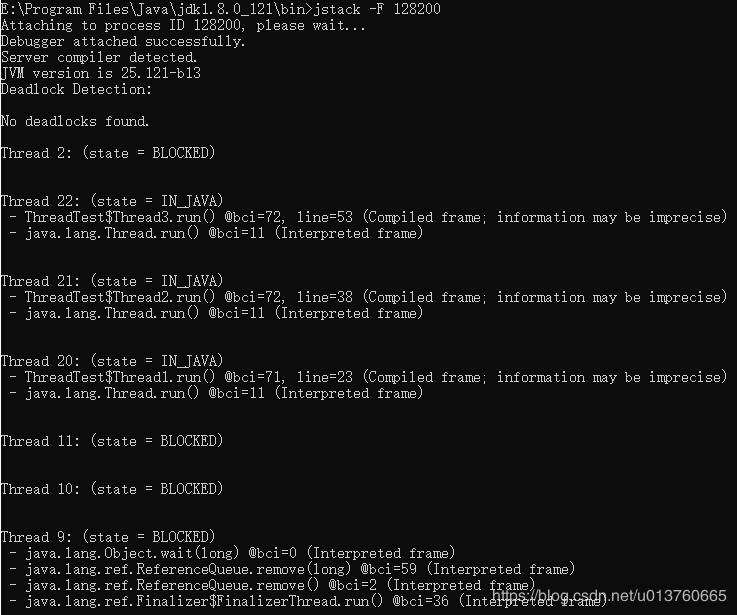Java實(shí)現(xiàn)多線程輪流打印1-100的數(shù)字操作
首先打印1-100數(shù)字如果用一個(gè)單線程實(shí)現(xiàn)那么只要一個(gè)for循環(huán)即可,那么如果要用兩個(gè)線程打印出來(lái)呢?(一個(gè)線程打印奇數(shù),一個(gè)線程打印偶數(shù))于是大家會(huì)想到可以通過(guò)加鎖實(shí)現(xiàn),但是這樣的效率是不是不高?這里我用一個(gè)變量來(lái)控制兩個(gè)線程的輸出
public class ThreadTest { volatile int flag=0; public void runThread() throws InterruptedException{ Thread t1=new Thread(new Thread1()); Thread t2=new Thread(new Thread2()); t1.start(); t2.start(); } public class Thread1 implements Runnable{ public void run() { int i=0; while(i<=99){ if(flag==0) { System.out.println('t1='+i+'flag='+flag); i+=2; flag=1; } } } } public class Thread2 implements Runnable{ public void run() { int i=1; while(i<=99){ if(flag==1) { System.out.println('t2='+i+'flag='+flag); i+=2; flag=0; } } } }}
那么如果要實(shí)現(xiàn)三個(gè)線程輪流打印1-100的數(shù)字呢?是不是也可以用上面的方法實(shí)現(xiàn)呢?代碼如下
public class ThreadTest { private int i=0; private Thread thread1,thread2,thread3; private int flag=0; public void runThread() throws InterruptedException{ thread1=new Thread(new Thread1()); thread2=new Thread(new Thread2()); thread3=new Thread(new Thread3()); thread1.start(); thread2.start(); thread3.start(); } public class Thread1 implements Runnable{ public void run() { while(i<=100){ if(flag==0) { System.out.println('t1='+i); i++; flag=1; } } } } public class Thread2 implements Runnable{ public void run() { while(i<=100){ if(flag==1) { System.out.println('t2='+i); i++; flag=2; } } } } public class Thread3 implements Runnable{ public void run() { while(i<=100){ if(flag==2) { System.out.println('t3='+i); i++; flag=0; } } } }}
運(yùn)行結(jié)果

發(fā)現(xiàn)三個(gè)線程只打印了一次就停止不輸出了,是什么原因呢?
可以用jdk自帶的jstack來(lái)看看線程的狀態(tài),在windows系統(tǒng)中可以打開(kāi)cmd然后進(jìn)入jdk所在目錄,然后執(zhí)行Jsp,能查看到各線程id,然后執(zhí)行jstack -F pid就可以看的狀態(tài)了

可以看到幾個(gè)Thread state是BLOCKED,就是阻塞了,什么原因呢?
尷尬發(fā)現(xiàn)flag變量和i變量前面忘記加volatile,導(dǎo)致flag和i被線程讀取修改時(shí),其他線程不可見(jiàn),所以才導(dǎo)致上面的問(wèn)題出現(xiàn)。
在JVM中每個(gè)線程讀取變量到cache中時(shí)相互都是不可見(jiàn)的,也就是java五大內(nèi)存區(qū)中的程序計(jì)數(shù)器區(qū)域?qū)τ诿總€(gè)線程都是獨(dú)立的不共享的,只有堆內(nèi)存區(qū)和方法區(qū)是對(duì)所有線程都是共享的。
當(dāng)線程1讀取了flag和i的值,并對(duì)其進(jìn)行修改的時(shí)候,線程2并發(fā)運(yùn)行,并不知道flag和i值已經(jīng)改變,導(dǎo)致多線程數(shù)據(jù)不一致的情況,所以加了volatile后,當(dāng)線程讀取變量進(jìn)行修改后會(huì)“通知”其它線程這個(gè)值已經(jīng)進(jìn)行了修改。
import java.util.concurrent.atomic.AtomicInteger; public class ThreadTest { private volatile int i=0; private Thread thread1,thread2,thread3; private volatile int flag=0; public void runThread() throws InterruptedException{ thread1=new Thread(new Thread1()); thread2=new Thread(new Thread2()); thread3=new Thread(new Thread3()); thread1.start(); thread2.start(); thread3.start(); } public class Thread1 implements Runnable{ public void run() { while(i<100){ if(flag==0) { System.out.println('t1='+i); i++; flag=1; } } } } public class Thread2 implements Runnable{ public void run() { while(i<100){ if(flag==1){ System.out.println('t2='+i); i++; flag=2; } } } } public class Thread3 implements Runnable{ public void run() { while(i<100){ if(flag==2){ System.out.println('t3='+i); i++; flag=0; } } } }}
運(yùn)行結(jié)果

-----未完-----
補(bǔ)充知識(shí):Java n個(gè)線程輪流打印數(shù)字的問(wèn)題
一、兩個(gè)線程輪流打印數(shù)字。
加鎖實(shí)現(xiàn):
package lianxi; /* * 用鎖實(shí)現(xiàn)兩個(gè)線程輪流打印1——100 */public class Print1TO100TwoThread { private Object lock = new Object(); private int i = 0; Thread threadA = new Thread(new Runnable() { @Override public void run() { while (i <= 100) { synchronized (lock) { try { if (i > 100) break; System.out.println('threadA :' + (i++)); lock.notify(); lock.wait(); } catch (InterruptedException e) { e.printStackTrace(); } } } } }); Thread threadB = new Thread(new Runnable() { @Override public void run() { while (i <= 100) { synchronized (lock) { try { if (i > 100) break; System.out.println('threadB :' + (i++)); lock.notify(); lock.wait(); } catch (InterruptedException e) { e.printStackTrace(); } } } } }); public void startTwoThread() throws InterruptedException { threadA.start(); Thread.sleep(20); threadB.start(); } public static void main(String[] args) throws InterruptedException { new Print1TO100TwoThread().startTwoThread(); } }
用鎖效率太低,用一個(gè)變量來(lái)控制打印的順序。
package lianxi;/* * 用兩個(gè)線程輪流打印1——10;用所實(shí)現(xiàn)效率太低,用變量來(lái)控制 */public class PrinntNumTwoThread { private volatile int num = 0; private volatile boolean flag = false; Thread threadA = new Thread(new Runnable() { @Override public void run() { while (true) { if (num > 10) return; if (!flag) { System.out.println('threadA-->' + ':' + (num++)); flag = !flag; } } } }); Thread threadB = new Thread(new Runnable() { @Override public void run() { while (true) { if (num > 10) return; if (flag) { System.out.println('threadB-->' + ':' + (num++)); flag = !flag; } } } }); public void startTwoThread() { threadA.start(); threadB.start(); } public static void main(String[] args) { new PrinntNumTwoThread().startTwoThread(); }}
二、那么如果要實(shí)現(xiàn)三個(gè)線程輪流打印1-100的數(shù)字呢?
package lianxi; public class PrintNumThreeThread { private volatile int i = 0; private volatile int flag = 0; Thread threadA = new Thread(new Runnable() { @Override public void run() { while (true) { if (i > 100) return; if (flag == 0) { System.out.println('threadA->' + ':' + (i++)); flag = 1; } } } }); Thread threadB = new Thread(new Runnable() { @Override public void run() { while (true) { if (i > 100) return; if (flag == 1) { System.out.println('threadB->' + ':' + (i++)); flag = 2; } } } }); Thread threadC = new Thread(new Runnable() { @Override public void run() { while (true) { if (i > 100) return; if (flag == 2) { System.out.println('threadC->' + ':' + (i++)); flag = 0; } } } }); public void startThreeThread() { threadA.start(); threadB.start(); threadC.start(); } public static void main(String[] args) { new PrintNumThreeThread().startThreeThread(); }}
以上這篇Java實(shí)現(xiàn)多線程輪流打印1-100的數(shù)字操作就是小編分享給大家的全部?jī)?nèi)容了,希望能給大家一個(gè)參考,也希望大家多多支持好吧啦網(wǎng)。
相關(guān)文章:
1. python GUI庫(kù)圖形界面開(kāi)發(fā)之PyQt5動(dòng)態(tài)(可拖動(dòng)控件大小)布局控件QSplitter詳細(xì)使用方法與實(shí)例2. CSS3實(shí)例分享之多重背景的實(shí)現(xiàn)(Multiple backgrounds)3. js開(kāi)發(fā)中的頁(yè)面、屏幕、瀏覽器的位置原理(高度寬度)說(shuō)明講解(附圖)4. CSS清除浮動(dòng)方法匯總5. 不要在HTML中濫用div6. XML入門(mén)的常見(jiàn)問(wèn)題(三)7. Python數(shù)據(jù)分析JupyterNotebook3魔法命令詳解及示例8. ASP動(dòng)態(tài)include文件9. ASP將數(shù)字轉(zhuǎn)中文數(shù)字(大寫(xiě)金額)的函數(shù)10. vue跳轉(zhuǎn)頁(yè)面常用的幾種方法匯總

 網(wǎng)公網(wǎng)安備
網(wǎng)公網(wǎng)安備